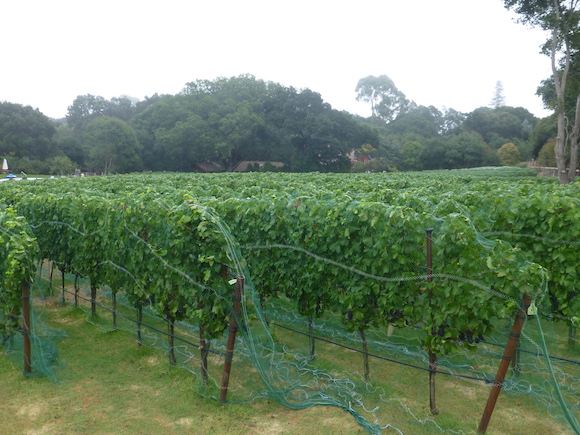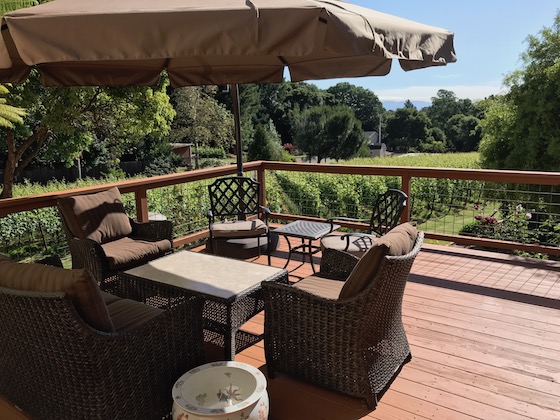
Saw this wonderful article on how to tell it is harvest time in Wine Country by Peg Melnik…if you have never experienced a wine grape harvest, you are missing out on the excitement. Here at Turtle Vines we expect harvest to the around September 20th, give or take…will see how the next months weather cooperates!
The famous writer obviously forgot one important caveat: except during harvest.
As the decidedly uncivilized harvest season unfolds in Sonoma and Napa counties over the next few weeks we’ll see the signs –– the media circus, the gawkers and the tourists –– all craving a glimpse of how wine is birthed.
Their photos, of course, won’t capture the spectacle — the joy in the midst of the contractions. And it’s a messy, long labor, not unlike that of comedian Rita Rudner who complained “life is tough enough without having someone kick you from the inside.”
Sleep deprivation, of course, isn’t the half of it. These harvest pickers often risk their lives, and most certainly their sanity, for the optimal pick.
Case in point. For more than two decades 78-year-old Lee Martinelli has teetered on his tractor, defying gravity on Jackass Hill that, with a 60 percent slope, is the steepest vineyard in Sonoma County. Keep in mind this steep slope isn’t even legal in Sonoma County anymore, but the hill at Martinelli’s winery in Windsor was grandfathered in. The vintner keeps his boots loose when he harvests his prized zinfandel in case he needs to jump ship should the tractor take a spill.
Like the hijinks of Jackass Hill, there’s a hilarity to harvest, whether you love it or you hate it, whether you want to curse the diva or celebrate her. Clearly harvest time makes strange bedfellows. It’s that odd mix of strange and wonderful. Just when winemakers think its intensity will send them over the edge, they’re spared by exuberance.
1. Stocking Up — You’ll notice some Type-A winemakers making a Costco run to buy ungodly amounts of frozen dinners. The jury is out on which brand is more popular — Amy’s, which is vegan-friendly, or Stouffer’s, which offers full-on, soothing comfort food. Whatever the case, these winemakers have it all dialed in. They refuse to cook during harvest — they thaw.
5. Starfleet Academy — When you hear five languages across seven barstools in Healdsburg, that’s when you know they’ve arrived — this year’s international class of harvest interns. While their motto isn’t “Ex astris, scientia” — “From the stars, knowledge,” the sentiment is the same. They aim to drink in knowledge by day, and drink in everything else by night.
6. The Ripening — It’s not a horror film — yet –– but The Ripening movie could be filled with the same supernatural intrigue. Winemakers see ripening as magic and they use it as a clock to tell time. They know they’re getting close to harvest when grapes in the vineyard go through the process the French call veraison (verr-ray-zohn). In this mysterious transformation, green grapes turn red, while white grapes become translucent. Other telltale signs from the cosmos include ripe blackberries and tomatoes on the vine, and that sexy flower, Naked Ladies, popping up all over the place.
8. The Walking Dead— You’ll see people who are dazed and confused, the delirious who can no longer separate their days from their nights. Sadly, it has just occurred to them that there’s no clocking out in harvest. Keep in mind that sleep-deprivation is a form of torture. Winemaker Nico Cueva of Sonoma County’s Kosta Browne acknowledged some people can’t take the toll of harvest. He said “every year we have at least one intern who can’t take the pace and has to leave.”
10. Euphoria — During the fits of frustration, the convulsions of harvest, there is the inevitable joy. Winemakers who have been hibernating in their cellars most of the year, get to commune with nature. Goldschmidt said he loves harvest because “I get to experiment and create and that’s really what we do best.” Mick Schroeter, who makes wine for Sonoma County’s Sonoma-Cutrer Vineyards, said the coolest part of harvest is the excitement. “The pace of harvest builds and all hell breaks loose. Everybody is working full-tilt, crazy hours, weekends and you think ‘when is this craziness going to end?’ But getting out into the vineyards, watching the final stages of ripening and making those first picking decisions, it’s exhilarating! Is it worth the fuss? Absolutely.”

